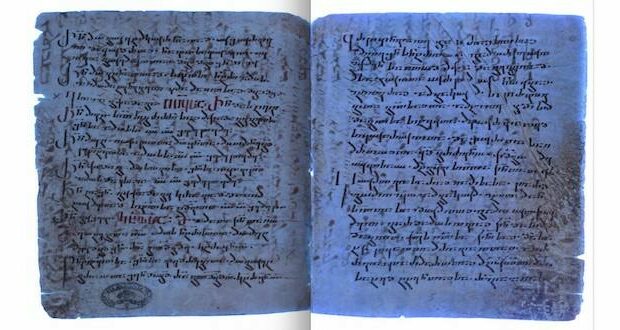Researchers using ultraviolet lights have uncovered a version of a Bible passage that had been hidden for 1,500 years.
The long-hidden chapter, an interpretation of Matthew chapter 12 originally was translated as part of what are known as the Old Syriac translations about 1,500 years ago. But thanks to the scarcity of parchment a couple of hundred years later in the region, that parchment was reused, mostly erasing the original translation of the biblical New Testament. A document like this, where one layer of text hides the erased remains of another, is called a palimpsest. The Kessel find is a double palimpsest because the parchment later was used a third time.
Historian Grigory Kessel from the Austrian Academy of Sciences unveiled this groundbreaking find in an article in the New Testament Studies academic journal, which is published by the Cambridge University Press. He said researchers found an ancient version of Matthew 12 that had been hidden beneath a section of text. His discovery is one of the earliest translations of the gospels, first created in the third century and copied in the sixth century.
READ: YouVersion Bible app celebrates half-billion downloads
“This discovery proves how productive and important the interplay between modern digital technologies and basic research can be when dealing with medieval manuscripts,” said Claudia Rapp, director of the Institute for Medieval Research at the Austrian Academy of Sciences.
“The manuscript offers a ‘unique gateway’ for researchers to understand the earliest phases of the Bible’s textual evolution,” Kissel said. “It shows some differences from modern translations of the text.”
He used the example of Matthew 12:1, which in the original Greek translates as “At that time Jesus went through the grainfields on the Sabbath; and his disciples became hungry and began to pick the heads of grain and eat,” the newly discovered Syriac translation says, “… began to pick the heads of grain, rub them in their hands and eat them.”
In an interview with Live Science, Kessell says he knows of only one other Gospel copy that shares the disciples “rubbed” grain in their hands.
Sebastian Brock, a retired professor of Syriac at the University of Oxford, told Live Science,”This is indeed an exciting discovery, and a brilliant piece of decipherment.”
He noted that Old Syriac and Old Latin copies of the gospels often differ from later versions. By the middle ages, the gospels became standardized.
–Dwight Widaman | Metro Voice
 Metro Voice News Celebrating Faith, Family & Community
Metro Voice News Celebrating Faith, Family & Community









